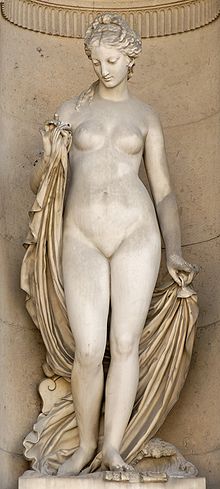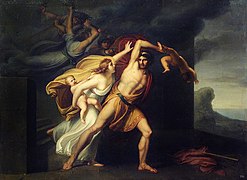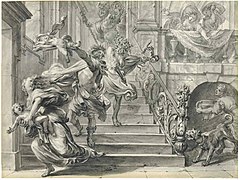Ino (mythology)
| Ino | |
|---|---|
Queen of Boeotia | |
| Member of the Theban Royal Family | |
 Leucothea (1862) by Jean Jules Allasseur (1818-1903). South façade of the Cour Carrée in the Palais du Louvre. | |
| Other names | Leucothea |
| Abode | Thebes, later Athamantia in Boeotia |
| Genealogy | |
| Parents | Cadmus and Harmonia |
| Siblings | Agave, Autonoë, Semele and Polydorus |
| Consort | Athamas |
| Offspring | Learchus and Melicertes |
In Greek mythology, Ino (/ˈaɪnoʊ/ EYE-noh; Ancient Greek: Ἰνώ [iːnɔ̌ː][1]) was a Theban princess who later became a queen of Boeotia. After her death and transfiguration, she was worshiped as a goddess under her epithet Leucothea, the "white goddess." Alcman called her "Queen of the Sea" (θαλασσομέδουσα thalassomédousa),[2] which, if not hyperbole, would make her a goddess parallel to Amphitrite.
Family
[edit]Ino was the second daughter of the King Cadmus and Queen Harmonia[a] of Thebes and one of the three sisters of Semele, the mortal woman of the house of Cadmus who gave birth to Dionysus. Her only brother was Polydorus, another ruler of Thebes. Together with her two sisters, Agave and Autonoë, they were the surrogates and divine nurses of Dionysus:
- Ino was a primordial Dionysian woman, nurse to the god and a divine maenad. (Kerenyi 1976, p. 246)
Ino was the second wife of the Minyan king Athamas, mother of Learchus and Melicertes and stepmother of Phrixus and Helle.
Mythology
[edit]
In the back-story to the heroic tale of Jason and the Golden Fleece, Phrixus and Helle, twin children of Athamas and Nephele, were hated by their stepmother, Ino. Ino hatched a devious plot to get rid of the twins, roasting all the crop seeds of Boeotia so they would not grow.[3][b] The local farmers, frightened of famine, asked a nearby oracle for assistance. Ino bribed the men sent to the oracle to lie and tell the others that the oracle required the sacrifice of Phrixus. Athamas reluctantly agreed.
Before he was killed though, Phrixus and Helle were rescued by a flying golden ram sent by their natural mother, Nephele. Helle fell off the ram into the Hellespont (which was named after her, meaning Sea of Helle) and drowned, but Phrixus survived all the way to Colchis, where King Aeetes took him in and treated him kindly, and gave Phrixus his daughter, Chalciope, in marriage. In gratitude, Phrixus gave the king the golden fleece of the ram, which Aeetes hung in a tree in his kingdom.
Later, Ino raised Dionysus, her nephew, son of her sister Semele,[c] causing Hera's intense jealousy. In vengeance, Hera struck Athamas with insanity. Athamas went mad, slew one of his sons, Learchus, hunting him down like a stag, and set out in frenzied pursuit of Ino. To escape him, Ino threw herself into the sea with her son Melicertes. Both were afterwards worshipped as marine divinities, Ino as Leucothea ("the white goddess"), Melicertes as Palaemon.
Alternatively, Ino was also stricken with insanity and killed Melicertes by boiling him in a cauldron, then jumped into the sea with her dead son. A sympathetic Zeus did not want Ino to die, and transfigured her and Melicertes as Leucothea and Palaemon.

The story of Ino, Athamas and Melicertes is relevant also in the context of two larger themes. Ino, daughter of Cadmus and Harmonia, had an end just as tragic as her siblings: Semele died while pregnant with Zeus' child, killed by her own pride and lack of trust in her divine lover; Agave killed her own son, King Pentheus, while struck with Dionysian madness, and Actaeon, son of Autonoe, the third sibling, was torn apart by his own hunting dogs. Also, the insanity of Ino and Athamas, who hunted his own son Learchus as a stag and slew him, can be explained as a result of their contact with Dionysus, whose presence can cause insanity. None can escape the powers of Dionysus, the god of wine. Euripides took up the tale in The Bacchae, explaining their madness in Dionysiac terms, as a result of their having initially resisted belief in the god's divinity.
After Ino's disappearance, some of her companions began to revile Hera, so the goddess turned them into birds according to Ovid,[4] perhaps aithuia birds (shearwaters?).[5]
When Athamas returned to his second wife, Ino, Themisto (his third wife) sought revenge by dressing her children in white clothing and Ino's in black and directing the murder of the children in black. Ino switched their clothes without Themisto knowing, and so Themisto instigated the murder her own children.
Transformed into the goddess Leucothea, Ino also represents one of the many sources of divine aid to Odysseus in the Odyssey (5:333 ff), her earliest appearance in literature. Homer calls her
- "Ino-Leocothea of the beautiful ankles [καλλίσφυρος], daughter of Cadmus, who was once a mortal speaking with the tongue of men, but now in the salt sea-waters has received honor at the hands of the gods".
She provides Odysseus with a veil and tells him to discard his cloak and raft, than instructs him how he can entrust himself to the waves and succeed in reaching land, and eventually the island of Scheria (Corcyra), home of the Phaeaceans.
In historical times, a sisterhood of maenads of Thebes in the service of Dionysus, traced their descent in the female line from Ino. We know this because an inscription at Magnesia on the Maeander summoned three maenads from Thebes, from the house of Ino, to direct the new mysteries of Dionysus at Magnesia.[6]
Festivals
[edit]Inoa (Ἰνῶα), there were festivals which were celebrated in many different places in honour of Ino.[7]
Genealogy
[edit]Gallery
[edit]-
Atamante preso dalle Furie, by Arcangelo Migliarini (1801) Accademia di San Luca, Roma, IT
-
Athamas und Ino by Radierung (17th century)
-
The insane Athamas killing Learchus, while Ino and Melicertor jump into the sea, by Wilhelm Janson (Amsterdam, NL), Antonio Tempesta (Italy, Florence, 1555–1630) at Los Angeles County Museum of Art, Los Angeles, CA
-
Tisiphone maddens Athamas & Ino (17th century)
-
Athamas tearing apart his children, by Godfried Maes
Notes
[edit]- ^ In Theogony she is only called "Ino", and is listed among the "glorious offspring" of unions between a mortal and a goddess. (Hesiod 1914, pp. 975 ff)
- ^ However Kerenyi (1951, p. 264) suggests "... it is possible that originally she did not cause the seed-corn to be roasted, but introduced the practice of roasting corn in general."
- ^ Local tradition sited the suckling of Dionysus at Brasiai in Laconia. (Kerenyi 1951, p. 264)
References
[edit]- ^ Liddell, Henry George; Scott, Robert, eds. (1940). "Ἰνώ" [Ino]. A Greek-English Lexicon. Oxford, UK: Clarendon Press. Archived from the original on 21 March 2023. Retrieved 18 July 2024 – via Tufts University (perseus.tufts.edu).
- ^ Ἀλκμάν (1988). "Fragment 50b". In Campbell (ed.). Alcman Fragments. Loeb Classical Library. Cambridge, MA: Harvard University Press. pp. 428, 429 – via Harvard U. Press (loebclassics.com).
- ^ pseudo-Apollodorus (1921), 1.9.1
- ^ Janan, Micaela (22 October 2009). Reflections in a Serpent's Eye: Thebes in Ovid's Metamorphoses. Oxford New York: Oxford University Press. p. 93. ISBN 978-0-19-955692-2.
- ^ Aratus (10 June 2004). Aratus: Phaenomena. Classical Texts and Commentaries. Vol. 34. Translated by Kidd, Douglas. Cambridge University Press. p. 293. ISBN 0-521-58230-X.
- ^ Burkert (1992), p. 44
- ^ "Ἰνῶα" [Inoa]. A Dictionary of Greek and Roman Antiquities. 1890 – via perseus.tufts.edu (Tufts University).
Sources
[edit]- pseudo-Apollodorus (1921). "Online version". Bibliotheca [The Library]. Translated by Frazer, J.G. Cambridge, MA / London, UK: Harvard University Press / William Heinemann Ltd. ISBN 0-674-99135-4 – via Perseus Digital Library, Tufts University (perseus.tufts.edu) (2 volumes). — "Greek text" – via Perseus Digital Library, Tufts University (perseus.tufts.edu).
- Burkert, Walter (1992). The Orientalizing Revolution: Near Eastern influence on Greek culture in the early Archaic Age. Cambridge, MA: Harvard University Press.
- Campbell, David A. (1988). "Volume II: Anacreon, Anacreontea, choral lyric from Olympus to Alcman". Greek Lyric. Loeb Classical Library. Vol. 143. Cambridge, MA: Harvard University Press. ISBN 978-0-674-99158-3 – via Harvard U. Press (loebclassics.com).
- Dalby, Andrew (2005). The Story of Bacchus. London, UK: British Museum Press. pp. 36–42, 151. ISBN 0-7141-2255-6. (US ISBN 0-89236-742-3)
- Hesiod (1914). "Theogony (English translation)". The Homeric Hymns and Homerica. Translated by Evelyn-White, H.G. Cambridge, MA / London, UK: Harvard University Press / William Heinemann Ltd. Retrieved 18 July 2024 – via Perseus Digital Library (Tufts University). "Greek text also available" – via Perseus Digital Library (Tufts University).
- Kerenyi, K. (1976). Dionysus: Archetypal image of indestructible life. Princeton, NJ: Bollingen.
- Kerenyi, K. (1951). The Gods of the Greeks. London, UK: Thames and Hudson.
External links
[edit] Media related to Ino at Wikimedia Commons
Media related to Ino at Wikimedia Commons
- Greek goddesses
- Family of Athamas
- Princesses in Greek mythology
- Queens in Greek mythology
- Metamorphoses characters
- Metamorphoses in Greek mythology
- Deeds of Hera
- Mythological Thebans
- Boeotian mythology
- Theban mythology
- Mythology of Dionysus
- Suicides in Greek mythology
- Metamorphoses into birds in Greek mythology
- Odyssean gods








